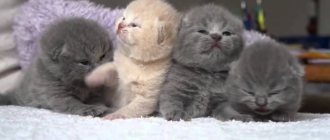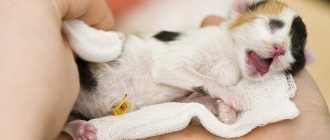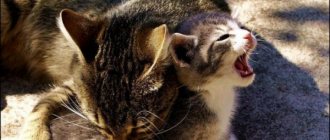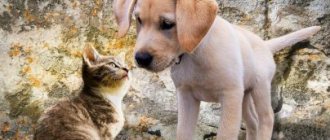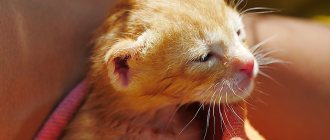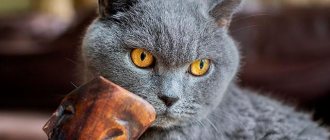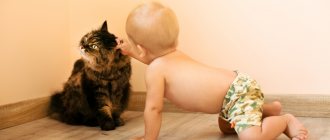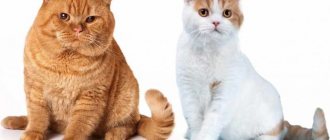Scottish Folds have an unusual appearance, but in early childhood they are very similar to British Shorthair cats. Newborn cats can be Scottish and Highland, Straight and Fold. But it is impossible to immediately find out what shape the baby’s ears will be. Let's find out by what signs and at what age you can determine the presence of lop ears in a kitten.
7-12 months
Stages of further development of Scottish cats:
7 months. It's time for puberty
When the first shedding occurs, it is important to comb the fur on time and make sure that the animal does not swallow its own hairs. They offer him cat grass and a special hair removal paste. 8 months
Castration and sterilization are carried out. 9 months. Scottish already resembles an adult cat, but he can still continue to be given baby food. 10 months. Animals actively demand “love acquaintances.” However, mating at such an early age is undesirable - the cat’s body has not yet formed for procreation. 11 months. The animal is gradually transferred to adult food. The frequency of lunches is reduced to 3 times a day.
One-year-old “Scots” are no longer growing. However, they continue to develop: gain mass, increase in width, build muscle. This process is completed by 2-2.5 years.
Scottish cats at 9 months:
Photos, videos of Scottish cats at 1 year:
Possible colors of the Scottish Fold
This cat breed is famous for its huge variety of colors thanks to the rich genetic heritage of the British Shorthair - the breed from which the Scottish ones were bred.
Such cats and cats are rarely of the same color. Most often, a cat's color consists of two, or even three.
So, the most common colors:
- Solid;
- Tortoiseshell;
- Bicolor;
- Tabby;
- Marble;
- Smoky;
- Calico.
Solid color - solid - black, lilac, blue or variations thereof. With this coloration, the entire body of the animal is painted uniformly in one color.
The smoky or Smoke color has an interesting feature of uneven distribution of color over each hair. The undercoat is usually light, and the tips of the hairs have quite dark tones.
The tabby pattern is the second most popular color among cats of this breed. The animal is covered with stripes and spots, which are called tabby. They are much darker than the rest of the fur. In addition, an indispensable attribute is the letter “M” made of stripes of dark wool on the forehead.
With bicolor coloring, the main colors for a Scottish cat will be only two colors, one of them is white, the other is any darker. It covers the back, tail and top of the head, while the belly, tips of the paws and chin are painted white.
The color point color is considered by breeders to be one of the most beautiful. With this coloring, the tips of the cat's paws, ears and mask on the cat's face are dark, and the entire body is light in color.
One of the rarest and most valued colors is considered to be calico. This color is often called “patchwork tortoiseshell.” It is found only in cats and is essentially a combination of bicolor and tortoiseshell. That is, the lower part of the cat’s body will be painted white, and the upper part will have a tortoiseshell color. A cat of this color is considered to be a carrier of genes for various colors, and therefore is especially valued for the reproduction of offspring.
Determining gender in other ways
There are several other methods for determining whether a kitten belongs to one gender or another. Below we will look at which are reliable and to what extent.
By color
A very reliable method if we are talking about a tortoiseshell kitten: black, blue-cream or patchwork (tri-color) “tortoise”. A tortoiseshell kitten is 99% of the time a cat. This is explained by the fact that all colors without exception are formed by two genes - “black” and “red” (red). Blue and cream colors are “lightened” blacks and reds.
The color gene is always transmitted by the female X chromosome, so there can be no discrepancies in cats: XY - one color, black or red, transmitted by the mother. Cats have two chromosomes carrying color genes: XX - therefore, it is possible to transmit either red or black genes, or both at the same time, which gives the tortoiseshell color.
Tortoiseshell boys are born very rarely, and their color is a genetic deviation (extra X chromosome: XXY - giving the wrong second color gene). Therefore, “tri-colored” cats are born sterile. All other colors are normal for both sexes.
By voice
With a certain stretch, one can consider the method effective: it is believed that cats have more low overtones in their voices, and cats have more high ones. In fact, quite a few cats have a rather gentle contralto voice, and the voices of some cats, on the contrary, sound menacing and not at all feminine.
In the face
It is believed that the outlines of the girl’s face are more subtle and soft, while the “portrait” of the cat is sculpted roughly, with wider cheekbones and the back of the nose. In reality, the method, of course, cannot be considered reliable. “Facial features,” like in humans, are inherited from parents. Which makes it more than likely both the subtle aristocratic features of the cat’s appearance and the harsh features of some four-legged young ladies.
Moreover, there are breeds of cats (a striking example is the Maine Coon), whose breed phenotype obliges them to look like wild, angry predators, regardless of gender. There are also breeds of graceful, fine-boned cats, the characteristics of which are reflected in the features of the males enough to confuse the untrained eye.
By weight
Weight is a criterion by which it is theoretically possible to determine the sex of an animal, but the reliability of the method is very low. It can be considered more or less reliable in two cases:
- If daily control weighings of the litter show a consistently high weight gain of some kittens compared to others (indicators vary for different breeds and individual body characteristics of animals).
- If size and weight are breed-forming characteristics and significantly exceed the values possible for cats, with a high degree of probability the luxurious dimensions belong to the representative of the stronger half. The disadvantage of this method is that by the time they reach the indicative size and weight, the animals have already grown enough to easily determine gender based on anatomical characteristics.
Veterinary method
You can accurately find out the gender of a kitten by contacting a veterinary clinic. If a visual examination by an experienced veterinarian does not allow accurate results (for example, when the length and thickness of a very small kitten’s fur “confuses the indications”), there is always the opportunity to donate blood for a test. It makes sense to resort to this method when it is the only way, and for some reason the result needs to be known urgently.
How to distinguish a straight-eared cat from a fold-eared one with erect ears?
As we have already said, sometimes over time a lop-eared kitten's ears will rise. Why can cats' ears go up? This is influenced by various factors, including the number of folds. As a result, if a fold's ears rise, it may be considered a straight. This is not particularly important if you do not intend to crossbreed your pet. But if there are such plans, you will have to conduct a genetic examination: folds cannot be crossed with folds, therefore, if your cat is a fold, and you, thinking that he is a straight, pair a fold, the offspring will be sick. At the same time, it is recommended to neuter Folds with mature ears.
Experienced breeders advise those who want to distinguish a Straight from a Fold with erect ears to pay attention to their size. Straights have quite large ears, sometimes even too large. And with folds they are always noticeably smaller.
This is what folds look like with their ears standing up. Please note that the ears do not have sharp tips and are small
Source
On the eve of childbirth
Usually a woman in labor copes with childbirth on her own, but a responsible owner should keep ready everything that may be useful during childbirth: clean towels, disposable diapers and gauze napkins, scissors and thick threads in case you have to cut the umbilical cord yourself, boiled water and a first aid kit, the contents of which should be discussed with your veterinarian in advance.
If your pet is constantly being observed by the same doctor, ask him for a phone number before giving birth in case of unforeseen circumstances or find contacts of a veterinary hospital where 24-hour consultation is available. Also make sure that you can go to the nearest veterinary clinic at any time, which is always open and you know the way to it and its exact address, in case you have to get there by taxi or on your own.
Childbirth is a moment of crisis for any cat and requires control from the owner
If a cat gives birth safely at home, she will eat the afterbirth after the kittens - this is absolutely normal. Some experts believe that it is enough to give the cat the afterbirth of only one kitten - especially if she has problems with the gastrointestinal tract. By the way, if the labor is long, then it is allowed to feed and water the woman in labor - this will give her strength. After giving birth, you need to clean the nest and leave the cat alone - she will have to carefully lick and feed each kitten.
Character
Scottish Folds are a friendly and affectionate cat breed. The character of the animal is calm, persistent, it easily tolerates the cuddling of small children. A cat will never hurt a person, will not bite or scratch him if she doesn’t like something. Therefore, a Scotsman can be safely adopted into a family with a small child.
The animal does not run the house, does not scatter objects, does not dig up the soil of their flower pots. Although it is worth noting that this breed is very playful and does not miss a chance to have fun with its favorite toy. Cats are very responsive, prefer to be around people, cannot stand loneliness, and require communication and affection. They often spend time on their owner's lap or in his bed. But at the same time they remain independent beings.
As a rule, Scots rarely voice, most often they purr. The animal's voice is quite creaky, a little harsh or squeaky. The cat will not wake you up at night with his chants or persistently beg for food with cries. Scottish Fold cats are not shy and are not afraid of loud or rustling sounds. Curious. They get along easily with other animals and are friends with birds, dogs, and chinchillas.
Rules for determining lop ears
You can determine whether a kitten is a fold-eared cat or not, not only by the appearance of the little Scotsman, but also by using some additional methods:
- Meet the parents of newborn Scottish Fold kittens. The father, as a rule, does not live with the offspring, but the cat is always with the babies for up to 2.5 months. She may belong to the Straight group, but if all the other breed characteristics are recognizable, then the litter must have fold-eared kittens.
- In order not to accidentally confuse a mestizo with a purebred animal, you need to inquire about the availability of documents. Even when the father is not around the kittens, breeders keep a photocopy of papers confirming his breed. If you have elite parents, you can understand that the fold-eared kitten in the litter will definitely not be a half-breed.
- If there is no confirmation of the breed of one of the parents, you should familiarize yourself with the mating documents. Felinological clubs always draw up an act according to the established template and register it. This will help you know that the fold-eared kitten was born legally.
- By the time the kitten is sold, the breeder must prepare metrics.
- If a small cat's ears stand up immediately after birth, this is normal. Folding is determined later. Therefore, you cannot take a kitten from the nursery before it turns 3 months old.
- In the early stages, even experienced experts cannot understand whether the kitten will be a fold or remain a straight. An ordinary cat, especially a mixed-breed cat with a high proportion of Scottish blood, may look like a purebred cat in the first weeks. But the difference will definitely appear by 3 months of age.
The choice of nursery or breeder is of great importance. Perhaps reputation can become a determining factor here. Owners know the capabilities of their pets better than others and predict in advance how many straight- and fold-eared babies a particular cat will have in the litter. They can give the most valuable advice on maintenance and always try to select only responsible and conscientious owners for the kids. Therefore, the final recommendation on how to avoid becoming a victim of scammers applies specifically to the behavior of breeders. They never give away very small kittens, they are always interested in the expected living conditions of their pets, willingly share advice, and show photographs of parent cats and children from previous litters. In this case, the buyer can be sure that he is purchasing a purebred Scottish Fold.
When Scottish kittens' ears droop - how to determine the correct ears?
If an owner wants to purchase a purebred Scottish Fold, he needs to know when Scottish kittens' ears droop. To do this, it is necessary to take into account the characteristics of the breed, be able to determine which animal’s ears are exactly bent, and also take into account at what period after the birth of the baby the ears are folded and pressed to the head, like a fold-eared cat.
Breeders recommend purchasing a fold-eared kitten during the cold season, since the heat makes even “correct” ears straight.
Rules for feeding three-week-old kittens without a mother
Three-week-old kittens are very vulnerable, although if you compare their size and potential ability to survive, you have a very good chance of being bottle-fed
It is important to understand that even if you do everything correctly, there is a risk of the kitten dying even at 3 weeks of age
Recently, veterinarians have not recommended resorting to homemade recipes for making milk substitutes, but trying to feed kittens only with ready-made formulas. This theory may be correct, but cat milk substitutes are rarely sold in small towns and villages. Below are recommended milk substitutes and recipes for preparing the mixture at home.
The general rules for feeding three-week-old kittens without a mother are that the guardian must perform all the manipulations that are assigned to the cat:
- Heating.
- Maintaining cleanliness.
- Taking care of your health.
- Feeding.
Until the kittens’ thermoregulation stabilizes, and this will happen at the age of 1 year 1.5 months, the temperature in the nest must be maintained at 25–28 degrees. The nest should be clean, safe, and located away from drafts and heating radiators.
For massage, use a clean cotton sponge soaked in warm water. The general idea is that you should imitate a cat licking itself. Without these manipulations, the kitten will not be able to go to the toilet and will die within 24 hours.
Wipe the kitten's face thoroughly after feeding and make sure that its fur does not stick together. The condition of the coat is one of the main indicators of health, which you will focus on when feeding a kitten artificially.
Naturally, the main aspect that ensures the survival of a three-week-old kitten that cannot eat on its own is timely, high-quality, balanced feeding. Let's take a closer look.
What you need to feed three-week-old kittens
First, let's figure out what is needed to provide the kitten with the most comfortable living and feeding conditions. Perhaps you already have something from this list; if not, you need to purchase what you need as soon as possible:
- A heating pad, preferably an electric one, with a regulator.
- Large supply of cotton and terry cuts.
- Gauze cuts and swabs.
- Cotton sponges.
- The gloves are disposable.
- Kitchen scales are the only way to track the development of a kitten, this is regular weighing.
- Moisture-wicking diapers.
- Feeding bottle - you can buy or make it. If you don’t have a bottle, you can use a syringe or pipette at first.
- A drug for children against colic, for example, Espumisan.
- A small box is a nest.
- Thick fabric that allows air to pass through well - cover the box so that the kittens are in the dark and do not worry.
- A soft toy with short hair - many kittens get very worried if their big and fluffy “mother” is not nearby.
If a three-week-old kitten is walking and has begun to open its eyes, you will need a bowl with low sides. A saucer can be used as a temporary alternative. As soon as the kitten begins to react to smells, silhouettes and shadows, you need to try to teach him to eat on his own.
Feeding methods
As mentioned above, there are different feeding methods. The kitten can be fed from a bottle, syringe or pipette. When feeding from a syringe, there is a risk of the piston slipping, as a result of which milk can enter the kitten’s respiratory tract. When feeding from a pipette, the kitten cannot suck, so the milk mixture stains the fur.
Three-week-old kittens hold their heads well, so during feeding you need to make sure that the baby is lying on his stomach. Especially for feeding, you can use a small plastic box so that while eating, the baby can rest his back paws on its side. If the first few times the kitten doesn’t eat well, a lot of formula spills and something doesn’t work out, don’t panic. It takes time for your baby to adapt to eating in an unnatural way.
Feeding mode
Most veterinarians recommend feeding kittens up to one month of age on demand. Try to develop a consistent feeding schedule based on the speed of food digestion depending on the age of the kitten.
The standard feeding regimen looks like this:
- From 14 to 18 days, kittens eat 9 times a day without a break for night sleep.
- From 18 days to 1 month, kittens eat 8 times a day without a break for night sleep.
Rules of care
There are few mandatory rituals for caring for Scottish dogs. The main thing is to accustom them to them from childhood, then later these procedures will be perceived calmly by them.
Combing and washing
It is enough to comb the kitten’s plush fur coat once every few days with a special brush for short-haired animals. You can use brushes with natural bristles or fine-toothed combs.
Wash kittens and adult cats as needed, but not more than once a month.
Wash kittens and adult cats as needed, but not more than once a month. “Bath” procedures for exhibition animals depend on the color of the animal’s coat. Folds that have dark colors are washed 7-10 days before the exhibition. Contrasting and light-colored cats should be washed 4-5 days before, and animals with light fur should be washed 2-3 days before the show; white cats should be washed on the day of the show or the day before.
Special shampoos do more than just care for your cat's fur. If you choose them correctly, they will also improve the quality of the fur coat. Nowadays there are detergents on sale that are designed for specific cat colors - whitening or making the dark color of the coat more saturated.
Nail care
One of those procedures to which a kitten must be accustomed from childhood. After all, if it is planned that a Scottish Fold cat will take part in exhibitions, his manicure (or pedicure) must be perfect.
When trimming nails, the kitten should be on your lap. Take the paw with your hand and gently press on the pad. The kitten will release white translucent claws. Carefully trim them with special tweezers, without touching areas with blood vessels.
Ear, nose, eye care
Like any cat, Scottish representatives of this family need regular cleaning of their ears, eyes and nose. You can wipe them with a cotton pad moistened with water or special lotions.
You can often find fold kittens with “flowing” eyes. This is not breed specific; any baby can have this. It is important not to start the process, but to use traditional remedies recommended by your veterinarian to eliminate the problem.
You can often find kittens with dripping eyes. This is not breed specific; any baby can have this.
Source
Duration of pregnancy
A cat's pregnancy lasts on average about 9 weeks. A more accurate period depends on many factors such as age, weight and breed characteristics. For example, owners have found that the process of bearing offspring in short-haired females lasts 58-68 days, in cats with long and medium-length hair it lasts 63-72 days.
How many kittens can a cat give birth to?
The length of pregnancy is also affected by the number of babies inside the womb. The more there are, the earlier the due date will come. Females bearing one to two kittens are able to walk for as long as possible before giving birth. In addition, their health depends on the number of cubs. Statistics show that babies from multiple litters are weaker and sicker.
For your information! In one litter, a female can bring from 2 to 8 kittens, the exact number of which depends on many factors.
What are the characteristics of the breed?
Fold-eared kittens gain their unusual appearance due to a gene mutation that causes their ears to curl and droop. Among the breeding animals, one is selected with drooping ears, the other with erect ears. Selection of 2 fold-eared individuals is not allowed, since the kittens are born weak and die. Sometimes they are crossed with ordinary individuals to avoid severe genetic defects. Therefore, in a litter there may be babies whose ears fall down over time, and those whose outer part of the hearing organ remains straight. The fact that the ears will droop or may straighten is not immediately clear at birth and becomes known after 3 weeks.
What should a cat normally do?
If everything is fine with the animal after giving birth, it will definitely take care of the offspring that are born: the cat’s task is to remove the remnants of the placenta from the kittens, lick them and push them in the direction of the nipples.
First, your pet carefully licks her babies, first of all freeing their eyes and nose from the mucus that got there during the birth process. After this, the animal takes the umbilical cord into its mouth and, chewing it (at the same time, the umbilical cord is effectively crushed), chews it. In addition, “experienced” women in labor carefully lick the umbilical area: the saliva that gets into the wound, rich in antibacterial substances, prevents the development of inflammation.
Finally, the cat carefully and diligently licks the anal area of each kitten individually. She does this for the effective removal of original feces. If the babies are not very “smart,” your pet will definitely push them towards the nipples. It is interesting that breeders have long made a simple and logical conclusion: kittens that “without prodding” accurately determine the direction of the “milk fountains” are 100% likely to grow up to be the largest and physically strongest.
Note that cats constantly nurse their babies for about an hour or two from the moment the latter is born. Since their eyes begin to open somewhere towards the end of the first week, the mother deliberately lies sideways to her babies so that they can always find nipples with milk. If your pet exhibits restless behavior and cannot calm down, forcefully put it down.
- After about two weeks, the cat no longer “indulges” the cubs so much, and only lies down to feed when they all start poking at her stomach at once.
- Starting from the age of four or five weeks, when the offspring have long and sharp teeth, the mother increasingly refuses to feed them and runs away, sometimes hissing indignantly.
- By eight weeks, kittens can be completely weaned and finally transferred to “adult” food.
Be sure to watch whether the cat licks the genital area of newborn kittens: for about three days, the instincts that promote natural bowel and bladder emptying do not work in babies, and therefore the mother must induce these processes artificially.
And she also has the unpleasant responsibility of eating all the excreted feces and urine (natural expediency - so that there is no smell of anything around the den). However, in practice such care often lasts much longer than three days, and the cat stops licking the “private” areas of her kittens only after the babies themselves can crawl outside the place of their birth.
Constant sleep of newborns - an alarming signal or normal development of the body
Newborn kittens sleep up to 22 hours a day. This is not a cause for concern, because at this time the baby’s nervous system is developing. Sleep contributes to the favorable course of this process. In the first months, the kitten should not be separated from its mother and brothers and sisters. If his weight is normal, it means that development is proceeding normally, and constant sleep is conducive to this.
Newborn kittens sleep up to 22 hours a day
You can familiarize yourself with sleep norms for the initial stages of a kitten’s life in the table.
| Age | Image | Number of hours of sleep |
| Newborn | 22 | |
| 3 weeks | 16 | |
| 1 month | 15-20 |
In order for a kitten to switch to nighttime sleep mode, it should be provided with sufficient activity during the day: play, run. Thus, by night he will be tired, sleep will be necessary to restore strength and will coincide with the biorhythms of the owners.
How to come to terms with loss
But sometimes kittens die, despite competent and timely help. There is no universal way to help ease the pain of loss. But those who have encountered such grief are advised to adhere to certain rules.
First, you should understand that it is normal to experience grief. Therefore, a person must give himself permission to suffer for a certain amount of time. It is advisable not to keep emotions to yourself, but to cry or shout them out in some deserted place (in the forest, in a closed car, or in a house when there is no one in it). Exercising or performing monotonous activities can also help distract you.
Secondly, it is necessary to get rid of the feeling of guilt for the death of the kitten. Paradoxically, the more effort a person makes to save his pet, the more he reproaches himself subsequently. You need to understand that the law of natural selection exists in nature and it is pointless to argue with it.
Thirdly, you should get a new furry pet. Some people, having experienced the loss of one kitten, do not dare to have another baby for fear of going through the pain again. But, as practice shows, the happiness that a new “family member” brings overcomes the bitterness of loss. In addition, new worries take up all my free time.
Also, after the kitten has died, the owner needs to decide what to do with the deceased animal. Most cities have laws that prohibit burying pets in flowerbeds and parks within the city. Therefore, it is best to take the kitten’s corpse outside the populated area and bury it in a picturesque place.
In large cities there are crematoriums and cemeteries for pets. This is an expensive procedure, but many wealthy people prefer to use such institutions.
They say that a dead animal runs to heaven on a rainbow. There is no need to darken his path with bitter tears. It is better to remember the happy moments spent together.
Scots diet
Scottish dogs, both straight and fold, have an excellent appetite. At the same time, they are not picky and enthusiastically take on any food.
For kittens, breeders recommend the use of balanced ready-made food. Babies up to 4 weeks should be fed with pate, which is then replaced with dry food when the pet reaches the age of 1 month.
It is preferable to choose products from the premium and superpremium categories. With a minimal carbohydrate content, they are rich in complete animal proteins.
In addition, the ready-made complexes contain the required amount of taurine, vitamins and microelements. The ideal option would be to alternately treat your pet with dry food and canned food.
One of the bowls should be constantly filled with clean water, changing daily. You should not give milk to a kitten; it can cause stomach upset in the Scotsman. Sometimes it is necessary to use sprouted wheat or oats to feed your pet. Eating fresh herbs will help clear your stomach of undigested hairballs.
Scottish Folds can also sometimes be pampered with rice and buckwheat porridges, which are most beneficial for cats. Giving oatmeal is contraindicated!
It is best to use milk for cooking, and after it is ready, supplement it with yogurt, kefir, acidophilus, fermented baked milk or cottage cheese. Porridge should have a very thin consistency, especially if it is cooked to feed newborn Scottish kittens.
When choosing natural food as the main one, it must be supplemented with vitamins suitable for the breed. You can diversify your kitten’s diet with boiled fish or pamper it with meat. Some people prefer vegetable dishes and bread.
Feeding food from your table, especially treats in the form of chicken bones, sweets and smoked meats, is strictly prohibited!
The second stage is independence and growing up
| Age | Image | Peculiarities | Recommendations |
| Sixth week | The final transition from mother's milk to foreign food | Feed the kitten 6 times a day, 40 grams of food at each meal. Observe the animal's stool; if there are any problems, contact a veterinarian after 3 days. | |
| Seventh week | Weight – 550-900 g. Males stand out among females in size | The kitten should not drink its mother's milk. Balance of dry and liquid food | |
| Eighth week | Weight – 750 – 1200 g. All milk teeth. Eats solid food | Separate from mother. Get examined by a veterinarian. Monitor the condition of your ears and eyes. Comb | |
| Ninth week | Forming a type of relationship with the owners | Get vaccinated | |
| Tenth week | Weight – 850-1400 g. Independence. Sensitivity to learning | Do not be aggressive in training | |
| Eleventh week | Research stage: exploring the corners of the apartment | Prevent the kitten from colliding with dangerous objects: close windows, remove small parts, toxic substances | |
| Twelfth week | Weight – 900-1600 g. Change of eyes Pet’s response to its name, to the call for food | Organize repeated prophylaxis against worms. Stop kitten aggression | |
| Thirteenth - fifteenth weeks | Weight – 1.5 kg. Molars appear | Feed 5 times a day. Trim nails regularly | |
| Sixteenth week | Weight – 1.8 kg | Get vaccinated | |
| Five months | Weight – 2 kg | Feed 4 times a day. Get a rabies vaccination | |
| Six months | Strong molars. Dimensions of an adult animal. Puberty | Organize worm prevention. Feed 3 times a day. Sterilize if there is no goal to breed offspring | |
| Seven months | Seasonal molt | Brushing your pet | |
| Eight – nine months | The cat is almost an adult | Sterilize if not done before. Consult your doctor about vaccination | |
| Ten – eleven months | Adult phase of life | Include food for adult cats in the diet |
Cat vaccination periods
Characteristic signs of appearance
Not everyone knows that Scottish Fold kittens are born with the most ordinary ears. By the first month of life, some ears remain straight, while others become recumbent, which makes them stand out among the felines. This trait, which has become the reason for special interest in the breed, is the result of a random mutation, so it is almost impossible to predict in advance which kittens will be in the litter.
From childhood, kittens have a round, hard head with powerful jaws. A feature of their muzzles are pronounced cheeks, which are especially noticeable in males. Model ears should be small and curved forward.
The Scottish Fold cat is known for its very expressive eyes. Large and round, combined with floppy ears, they always have a slightly amazed expression. The legs are strong, not very long, but not short either.
The average Scot weighs approximately 4-5 kg. Females are usually slightly smaller than males. Some representatives can reach 6-7 kg, or even more.
Scottish Fold cats have a wide range of colors. They can be any color, although the most common are gray and purple. Recently, red fold-eared kittens have become especially popular.
The breed also differs in the length of its coat:
- shorthair (Scottish fold);
- longhaired (highen fold).
Both have very soft and pleasant coats that require good care. This is especially true for long-haired representatives of the breed.
The red fold-eared cat is in particular demand, since this particular representative of the breed has a very gentle disposition and a beautiful color that looks like red marble.
The cat behaves strangely after giving birth - what to do and how to help?
Many owners are shocked when their pet suddenly becomes aggressive. A young mother may hiss, growl and even rush at the owner when trying to examine or touch the kittens. In fact, there is nothing surprising in this behavior, since no one except the mother can protect the kittens. The cat will not go to extremes if you take care of the comfort and safety of the family in advance.
To protect your pet from stress, place the nest in a separate room, away from guests, children and other pets. Try to ignore the presence of kittens when changing your cat's water or giving her food. Pay more attention to the young mother, praise her, try to behave as loyally as possible.
There is an explanation for aggression. In the wild, kittens can be threatened by adult males and females:
Males kill kittens so that the young mother comes into heat sooner and is ready for re-mating.
Females can kill kittens for the sake of obtaining “simple food” or out of jealousy. A cat that has recently given birth and lost offspring can steal other people's kittens, guided by maternal instinct.
Against the background of aggression, you may notice that the cat is hiding the kittens, covering them with her body. In such a situation, you cannot control whether all babies receive adequate nutrition. This behavior can be called normal if:
The cat does not leave the kittens for a long time or covers them with something before leaving the nest.
The pet leaves the nest to drink, eat and go to the toilet.
The cat does not try to take her kittens with her every time she goes somewhere.
You should see the kittens at least once a day, for example, while the cat is eating. If the kittens remain warm to the touch, you hear and see them squeaking and actively moving, it is better not to disturb the mother cat. If you suspect that the cat is not feeding the babies or is not paying enough attention to caring for them, you need to take action.
Most often, the reason for ignoring kittens, if we are not talking about postpartum depression, is the non-viability of the babies or congenital malformations. No matter how cruel it may sound, after giving birth, the cat can choose which kittens will survive and which are doomed.
Having stopped feeding weak babies, the cat pays maximum attention to stronger kittens. If you notice that your pet is ignoring specific kittens, they need to be taken from the nest and transferred to artificial feeding
It is advisable to consult a veterinarian who will examine rejected babies and be able to draw conclusions about developmental defects. In rare cases, a cat may reject kittens due to insufficient milk for feeding.
When ears drop: timing
After birth, a kitten’s ears do not yet acquire the necessary shape, so it is difficult to draw conclusions about what kind of cat was born. In a fold-eared cat, already on the 18th day after birth, folds form, and the shell itself is slightly tilted forward, opposite from the top of the head. The number of days can range from 21 to 24 days. The most preferable is a triple degree of ear bending. Both hearing organs must descend.
If the ends do not fall equally or unevenly, then over time they may stand up completely. Ears also rise when there are less than 1-2 folds, so the standard kitten should have 3 of them. It is best to see that the ears are erect or curled when the small cat is 3-4 months old. However, breeders recommend adopting a lop-eared baby at 4-5 months, when the teeth change and the baby's fur falls out.
Source
What to do if maternal instinct is violated?
If the cat was very exhausted from childbirth, or when the last one was frankly difficult and unsuccessful, your pet may simply not have the strength left to care for her offspring. In these cases, the role of “nanny” will have to be taken on by the owner himself.
We have already described above exactly how cats do this in natural conditions. Remember that you need to “imitate” maternal care as carefully as possible, without rushing.
So, the following is required of you:
- Gently remove the remaining membranes, wipe the kitten's nose and open the mouth, then slightly tilt the pet's head down and try to remove all the liquid and mucus from there.
- If the cat has not chewed off the umbilical cord either, measure about two centimeters from the kitten’s navel, tie the umbilical cord with silk thread, and then cut the “lace” (of course, over the knot you tied). The stump must be lubricated with alcohol tincture of iodine. Please note that you cannot simply cut the umbilical cord! We have already written that when a cat bites it, it simultaneously crushes the edges of the organ, thereby preventing the development of bleeding. If you simply cut the umbilical canal, your baby may bleed to death within minutes.
Experienced veterinarians advise using a urinary catheter connected to a regular syringe. In addition, you can massage the kitten’s throat, trying to induce a cough (if you’re lucky, the animal itself will spit out all the excess).
Rocking is another simple, but still quite effective method of resuscitation. To do this, place the kitten in your palm with its back facing down and squeeze its head (gently) between your thumb and index finger. After this, it is necessary to rock the baby for about five minutes, and at this time the hand should make movements like a rocking cradle. During motion sickness, fluids entering the respiratory tract will fluctuate and irritate the corresponding receptors. The latter stimulate coughing and, if the kitten is lucky, it will spit out all the excess.
Keep in mind that you shouldn’t pretend to be a centrifuge with your hand: you certainly won’t do anything better for the baby, but it’s quite possible to cause a hemorrhage in the cerebellum.
Character
The character of the Scottish Fold will appeal to many. These animals are kind, smart, moderately playful and calm. They love to play with various toys, and their favorite activity is where their owners are. It is difficult to describe how much these cats love their owners; they are ready to follow them to the ends of the earth.
These animals love attention and if your cat lacks it, he will definitely find you. Therefore, it is not advisable to get a Scottish Fold if you rarely appear at home
But in any case, don’t worry, he will wait for you and play even if he hasn’t seen you for a long time.
If you are a happy parent, then Fold will become your child’s best friend. This breed is very peaceful and does not like to scratch unnecessarily; it is not for nothing that they are often compared to soft toys because of their character and appearance.
Even in childhood, cats of this breed do not often play dirty tricks. The most they can do is hide your glasses or pen under the sofa.
Don't be alarmed if you've never heard any noise from your pet, they don't like to meow. It's funny that their voice is the opposite of their appearance, the meow of this breed is very squeaky and you will only be glad of the pet's silence.
Massage
We emphasize once again that the digestive system of premature kittens is almost always underdeveloped. Because of this, in particular, pets almost always have serious problems with peristalsis. In order to somehow stimulate it, it is necessary to regularly massage the abdominal cavity.
. It should be taken into account that even a cotton pad may be too hard for the extremely delicate skin of a premature kitten.
To avoid injuring the baby, turn on the tap, wait until warm (but not hot) water comes out and, directing it in a thin stream, massage the lower part of the kitten’s tummy, helping with your finger. Before doing this, it won’t hurt to cut your nails (yourself). If the kitten experiences discomfort during the procedure, its intestines will not be activated.
Childbirth in cats, just like in humans, can be unpredictable. On average, a cat bears kittens for 62-72 days. It is believed that premature birth in a cat occurs if the gestation period is less than 58 days. The reasons for early lambing can be different. The owner of the animal should know what to do in such cases.
What are the characteristics of the breed?
Fold-eared kittens gain their unusual appearance due to a gene mutation that causes their ears to curl and droop. Among the breeding animals, one is selected with drooping ears, the other with erect ears. Selection of 2 fold-eared individuals is not allowed, since the kittens are born weak and die. Sometimes they are crossed with ordinary individuals to avoid severe genetic defects. Therefore, in a litter there may be babies whose ears fall down over time, and those whose outer part of the hearing organ remains straight. The fact that the ears will droop or may straighten is not immediately clear at birth and becomes known after 3 weeks.
What diseases are Scottish cats prone to, and what is their life expectancy?
Purebred cats need to be vaccinated on time. In addition, it is necessary to carefully monitor the animal’s nutrition and carry out hygiene procedures. This is especially true for pregnant pets.
Gene mutations are the sad side of constantly crossing Folds with representatives of the same breed. The consequence of this was osteochondrodysplasia, in which bones and cartilage develop poorly, joints are destroyed and hurt. In addition to congenital pathologies, representatives of this species may suffer from other diseases:
- eye diseases - glaucoma, entropion, cataracts;
- diseases of the cardiovascular and digestive systems;
- skin diseases - allergies, eczema;
- ear pathologies – deafness, otitis media.
Vaccination is required. A Scottish kitten is first vaccinated at 2 months, then at 3 months. All vaccinations are given to Scottish kittens according to schedule. If there is no walking, the pet can become infected at home through clothes and shoes. Owners should carefully monitor the behavior of the animal and contact a veterinarian if there are any signs of illness.
Life expectancy depends on compliance with the rules of care and precautions. Heredity is an important factor
On average, Scottish cats live 15 years or more.
Recommendations for 1-3 months
Cats are naturally very clean creatures and do not normally require additional care. However, due to their age, kittens do not always cope with their hygiene procedures, and they need help with this.
Behind the eyes
Kittens need to regularly clean their eyes with a damp cotton pad (by the way, for Sphynx cats this is a different story altogether). You should be accustomed to such procedures from a very tender age and from the first days of the kitten’s stay in the apartment. Once a week, to prevent infections and cleanse your eyes more thoroughly, you can wipe them with a solution of boric acid (1/2 teaspoon of dry powder per glass of boiled water).
Nail trimming
Domestic kittens should only have the claws on their front paws trimmed. It is also worth accustoming to the procedure from the first days of life with the owners. Nails are trimmed approximately once a month - only the very tip is trimmed, no more than 2 mm, so as not to touch the blood vessels.
When to bathe and how?
Kittens are bathed only if necessary - if they are heavily soiled or if the presence of fleas is suspected. Fold-eared kittens are not allowed to bathe until they are two months old. Then bathe once every two to three months. Bath in warm water with special shampoo. After bathing, the coat must be dried to avoid hypothermia and colds.
The vast majority of kittens are afraid of the sound of water, so you should be careful with the pressure. It is better to fill the bathtub or basin with water in advance and water the baby from a ladle. For training, you can put rubber toys in the water.
The ears must be covered with cotton swabs during bathing. Oil drops are instilled into the eyes to prevent irritation of the mucous membrane in case of accidental contact with soapy water. The temperature should be about 36oC.
You need to wash all the products very carefully, because even after washing and drying the kitten will lick itself to remove the specific smell. Hot air is not used to dry the fur - only cold air at a distance of about half a meter from the kitten.
Ear cleaning
Ear inspection and cleaning should be done at least once a week. The auditory canal is carefully wiped from the outside with a cotton pad or cotton wool twisted into a flagellum.
It is better not to use cotton swabs - the kitten may pull away from the unpleasant sensations, and the swab itself may damage the ear, or the cotton swab from it may remain in the ear canal. Wax from the depths of the ear is not removed.
Scottish Fold coat care
Scottish Folds are naturally very clean and take care of their fur themselves. However, to reduce the clogging of the stomach with hairballs, you need to regularly, at least once a week, comb the animal with a special hair brush.
You can purchase them in special veterinary stores or pharmacies. For short-haired subspecies, a brush with short and frequent teeth is used; for long-haired counterparts, combs should have longer and sparse teeth.
Also, long-haired cats need brushing at least once every two to three days. During the molting period, brushing is carried out more often.


